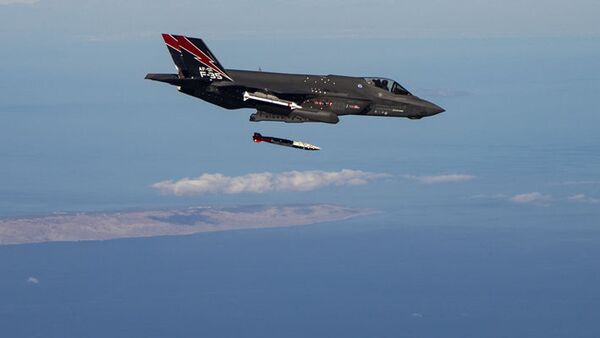For the first time, the US military has released footage of an F-35A Joint Strike Fighter dropping inert nuclear bombs at speeds in excess of the speed of sound. Tests of actual nuclear weapons are banned under a 1996 treaty.
The footage, compiled by Sandia National Laboratories, Los Alamos National Laboratory and the US National Nuclear Security Administration (NNSA), shows an August 25 flight test at Tonopah Test Range, part of the Nevada Test and Training Range that also houses Area 51. The video was, in turn, uploaded to YouTube by The Drive.
The Pentagon’s F-35 Joint Program Office previously published photos in June of other tests at California’s Edwards Air Force Base in which an F-35 also dropped dummy B61-12 nuclear bombs, noting the tests went back as far as June 2019.
“This was the first test to exercise all systems, including mechanical, electrical, communication and release between the B61-12 and the F-35A,” Steven Samuels, a manager with Sandia’s B61-12 Systems Team, said in a Monday news release. “The latest test is a critical piece in the F-35A and B61-12 program. Aboard the newest fighter, the B61-12 provides a strong piece of the overall nuclear deterrence strategy for our country and our allies.”
The B61-12 is the latest version of the B61 family of air-dropped nuclear gravity bombs, introduced in 2015. At just 12 feet long, the variable-yield weapon can fit inside the F-35’s internal weapons bay, meaning like its cousin the F-22 Raptor, it won’t have to sacrifice its stealthiness to carry the bomb. The B61-12 has four yield options: 0.3 kilotons, 1.5 kilotons, 10 kilotons and 50 kilotons.
The F-35 isn’t the only US aircraft capable of delivering nuclear weapons at supersonic speeds: the F-15 Eagle and F-16 Falcon can carry the B61 bomb too, and the F-15 has already been certified to carry the new version of the bomb. The subsonic but equally stealthy B-2 Spirit can also carry the B61, but also uniquely wields the much larger B83 thermonuclear bomb.

Despite the successful tests with dummy bombs, the F-35 isn’t yet certified to carry real nuclear weapons and the aircraft’s Block 4 upgrade has been delayed by almost a year, until at least March 2021. The software upgrade is necessary for the aircraft’s huge computer to “talk” to the bomb’s computer accurately.
With the F-35 expected to pick up the role of nuclear strike aircraft for a number of NATO allies that wield US nuclear weapons under a special weapons-sharing agreement as aircraft like the Panavia Tornado are retired, that could leave a gap in which they are unable to use the bombs at their disposal.

